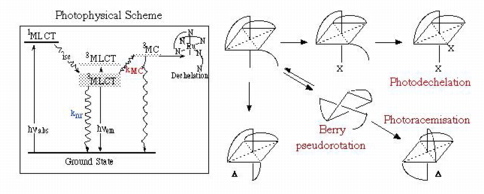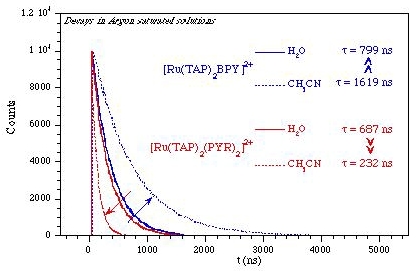
Photophysic of [Ru(TAP)2(pyridine2)]2+ (racemic mixture)

Scheme : Photophysical scheme of Ru(II) complexes and the role of 3MC excited state in the photodechelation and photoracemisation processes
The efficiency of these two processes is thus conditioned by the crossing to the 3MC state which depends primarily of the temperature and the energy gap between the 3MLCT and 3MC states.
A photophysical investigation of [Ru(TAP)2(pyridine)2]2+ was thus performed in order to evidence the importance of the 3MC state in its deactivation pathway.

Figure : Luminescence Decays of Ru(II) complexes in water and acetonitrile at room temperature in argon saturated solutions
Changing the solvent from H2O to CH3CN
This difference is attributed to different main activation pathways for the two complexes.
For [Ru(TAP)2bpy]2+ deactivation in aqueous solution is dominated by the radiationless deactivation from OH vibrators of the solvent as confirmed by an increase of lifetime in CH3CN and in D2O [1].
For [Ru(TAP)2(pyridine)2]2+ deactivation in aqueous solution is less sensitive to OH vibrators (as the lifetime only slightly increases in D2O) but is dominated by the crossing to the 3MC state. Indeed when changing the solvent from H2O (polar) to CH3CN (less polar), destabilisation of the 3MLCT occurs (charge transfer states are stabilised in polar solvents). Therefore, the energy gap between the 3MLCT and 3MC (which is less affected by the polarity of the solvent) decreaeses favoring still more the crossing to the 3MC state. This is also confirmed by the study of the temperature dependance of the lifetimes in CH3CN : weak for [Ru(TAP)2bpy]2+ and strong for [Ru(TAP)2(pyridine)2]2+.
This study confirm the importance of the crossing to the 3MC state for [Ru(TAP)2(pyridine)2]2+ and point out the importance of performing resolution experiments in the dark to avoid photoracemisation processes.
[1] A. Masschelein, L. Jacquet, A. Kirsch-De Mesmaeker and J. Nasielsky, Inorg. Chem.,1990, 29, 855-860
[2] G. Porter, R. Sparks, Journal of Photochemistry, 1980, 13, 123-131